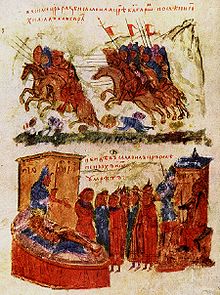
Back الحملة البيزنطية على بلغاريا Arabic Въстание на комитопулите Bulgarian Βυζαντινή κατάκτηση της Βουλγαρίας Greek Conquista bizantina de Bulgaria Spanish Guerre byzantino-bulgare de 970-1018 French Conquista bizantina da Bulgária Portuguese Ustanak Komitopula Serbo-Croatian Устанак Кометопула Serbian Bizans İmparatorluğu'nun Bulgaristan'ı fethi Turkish 拜占庭征服保加利亚 Chinese
| Byzantine conquest of Bulgaria | |||||||||
|---|---|---|---|---|---|---|---|---|---|
| Part of the Byzantine-Bulgarian wars | |||||||||
 The Byzantines defeat the Bulgarians at Kleidion and Tsar Samuel becomes unconscious at the sight of his blinded army. Scene from the Manasses Chronicle. | |||||||||
| |||||||||
| Belligerents | |||||||||
|
Bulgarian Empire Kievan Rus' (970–971) Pechenegs |
Byzantine Empire Kievan Rus' (968–969) Kingdom of Hungary Principality of Duklja Kingdom of Croatia | ||||||||
| Commanders and leaders | |||||||||
|
Samuel Roman Gavril Radomir Ivan Vladislav † Jovan Vladimir Krakra Ivats |
John I Tzimiskes Basil II Nikephoros Ouranos Theophylact Botaneiates † Nikephoros Xiphias Constantine Diogenes. David Arianites | ||||||||
From c. 970 until 1018, a series of conflicts between the Bulgarian Empire and the Byzantine Empire led to the gradual reconquest of Bulgaria by the Byzantines, who thus re-established their control over the entire Balkan peninsula for the first time since the 7th-century Slavic invasions. The struggle began with the incorporation of eastern Bulgaria after the Russo-Byzantine War (970–971). Bulgarian resistance was led by the Cometopuli brothers, who – based in the unconquered western regions of the Bulgarian Empire – led it until its fall under Byzantine rule in 1018.[1][2][3]
As the Byzantine-Bulgarian relations deteriorated by the end of the 960s, the Eastern Roman Empire paid the Kievan prince Sviatoslav to attack Bulgaria. The unexpected collapse of Bulgaria and Sviatoslav's ambitions to seize Constantinople caught the Eastern Roman Empire off-guard but they managed to pull back the Kievan armies and occupied eastern Bulgaria including the capital Preslav in 971. Emperor Boris II was captured and taken to Constantinople where he abdicated and the Byzantine Emperor John I Tzimiskes announced the annexation of Bulgaria, even though the Eastern Roman Empire only controlled Eastern Bulgaria at the time, and the lands to the west remained under Bulgarian control. The four brothers David, Moses, Aron, and Samuel of the Cometopuli dynasty ruled in the free territories and in 976, launched a major offensive against the Byzantines to regain the lost lands. Soon, the youngest brother, Samuel, took complete authority following the deaths of his three eldest brothers.
Samuel proved to be a successful general inflicting a major defeat on the Byzantine army, commanded by Basil II at the Gates of Trajan and retaking north-eastern Bulgaria. His successful campaigns expanded the Bulgarian borders into Thessaly and Epirus and in 998, he conquered the principality of Duklja. In 997, Samuel was proclaimed Emperor of Bulgaria after the death of the legitimate ruler, Roman.
By the end of the millennium, the fortunes of war turned into Byzantine favour. The Byzantines under Basil II, a successful general and experienced soldier, slowly gained the upper hand and from 1001, started to seize a number of important areas and towns. The Bulgarians were unable to stop the annual Byzantine campaigns which devastated the country. In 1014, the Byzantines won the decisive Battle of Kleidion and Samuel died a few weeks later. Tsar Samuel's reign was followed by the short reigns of his son Gavril Radomir and his nephew Ivan Vladislav. In 1018, Ivan Vladislav's widow, Maria, negotiated very favorable terms of surrender to the Byzantine emperor. All local lords who surrendered were transferred either to Constantinople or to Anatolia and most of them were later assimilated into the Byzantine society.[4] Bulgaria lost its independence and remained subject to Byzantium for more than a century and a half, until 1185.[5] Its western part was transformed into one of the many Byzantine provinces, which was ruled by a governor appointed by the Emperor.[6] With the collapse of the first Bulgarian state, the Bulgarian church fell under the domination of Greek ecclesiastics who took control of the see of Ohrid and attempted to replace the Bulgarian Slavic liturgy with a Greek liturgy.[7]
- ^ Byzantium's Balkan frontier: a political study of the Northern Balkans, 900–1204, Paul Stephenson, Cambridge University Press, 2000, ISBN 0-521-77017-3, pp. 58–66.
- ^ A short history of the Middle Ages, G – Reference, Barbara H. Rosenwein, University of Toronto Press, 2009 ISBN 1442601043, p. 143.
- ^ A history of Byzantium, Timothy E. Gregory, John Wiley & Sons, 2011, ISBN 1444359975, p. 322.
- ^ Southeastern Europe in the Middle Ages, 500–1250, Florin Curta, Cambridge University Press, 2006, ISBN 0521815398, pp. 246–247.
- ^ East Central Europe in the Middle Ages, 1000–1500, Jean W. Sedlar, University of Washington Press, 1994, ISBN 0295972904, p. 364.
- ^ History of the Byzantine Empire, 324–1453, Aleksandr Aleksandrovich Vasilʹev, Univ. of Wisconsin Press, 1958, ISBN 0299809250, p. 320.
- ^ Britannica: The first Bulgarian empire.
© MMXXIII Rich X Search. We shall prevail. All rights reserved. Rich X Search